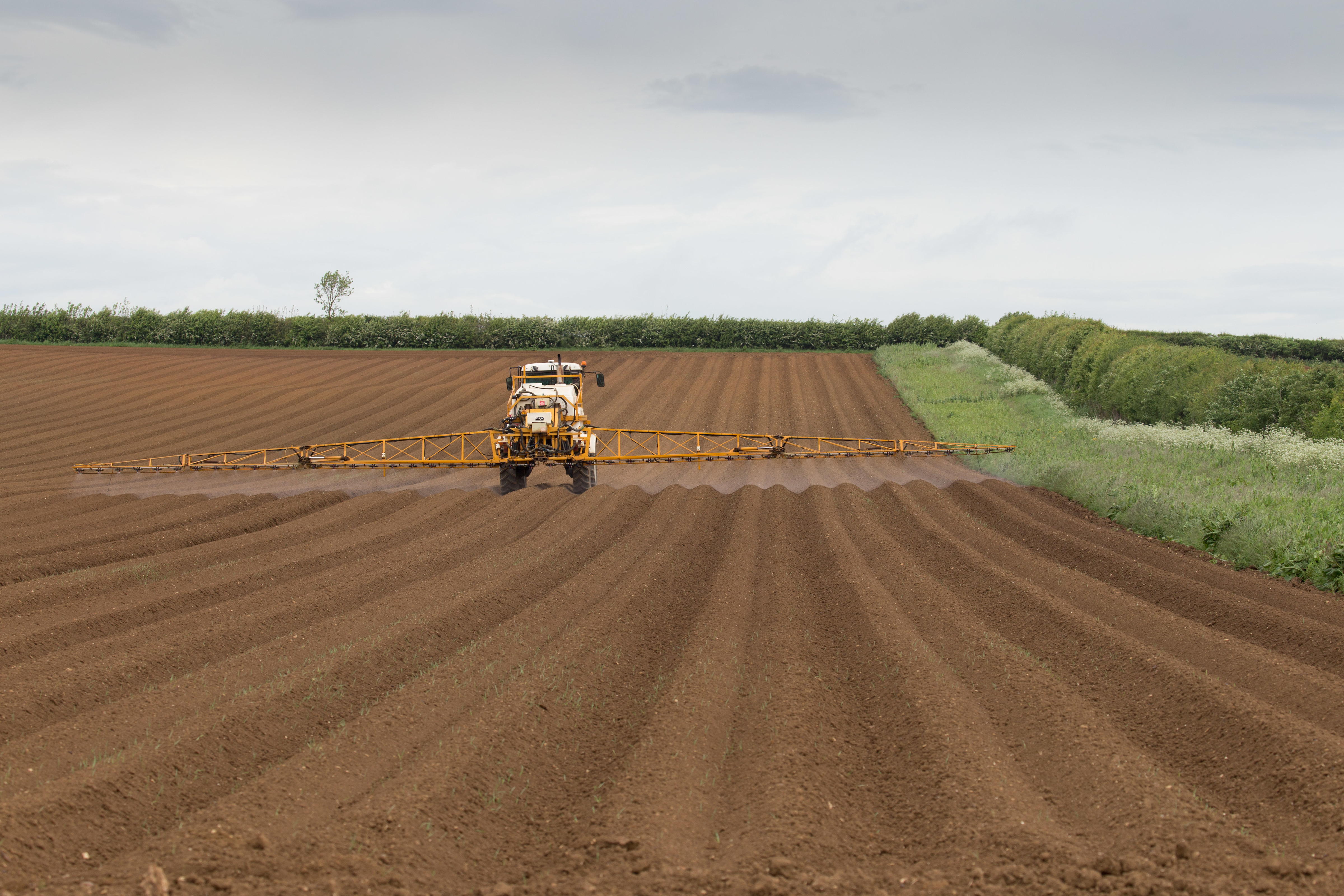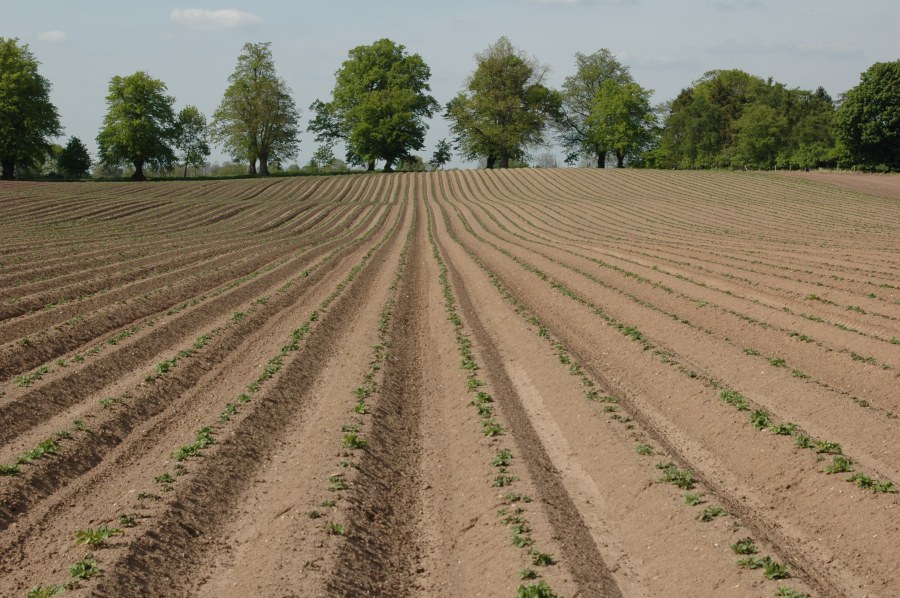It’s time to look elsewhere as the EU Commission finally calls time on diquat. CPM finds out how contact pre-emergence weed control strategies may adapt.
This must be the year to actively try new systems.
By Lucy de la Pasture and Rob Jones
For most UK potato growers and their advisers, including Monmouthshire-based agronomist Juliet Anderson, there was probably a sense of déjà vu following last Oct’s announcement confirming diquat wouldn’t be renewed.
“It seems to have been an open industry secret for the past two years that diquat would go the same way as paraquat and linuron, so now that we have closure, we can at least move on to look at alternative strategies for early weed control and address the potentially bigger headache of desiccation without diquat,” she says.

Timing of pre-emergence contact herbicides will need to be more focused to avoid causing crop damage.
With just over 20 years’ field experience as an agronomist, Juliet advises on 600ha of potatoes across Herefords and Glos, most of which are destined for the crisping and chipping markets. It’s a very challenging geographical area, where much of the rented land for potato production is sourced from livestock farmers, and Juliet is quick to acknowledge the problems in tackling a very broad weed spectrum when planning early season weed control.
“With its grace period officially over by next Feb, there’ll be a temptation to use diquat again in the same systems but, in my opinion, this must be the year to actively try new systems without it and get a proper feel for what works best,” she says.
“Over the past two years I have already used Gozai (pyraflufen-ethyl) as an alternative to diquat on my seed crops and the ware crops I didn’t want to harvest too quickly. It’s proved to be as good as carfentrazone and actually outperformed it on some varieties, most notably on seed crops such as Taurus.
“On the basis of these good results in previous seasons, my plan is to now also incorporate Gozai within my early season strategy and I’ll be applying my key residuals, Praxim (metobromuron) plus Defy (prosulfocarb) or metribuzin plus prosulfocarb 14 days after planting,” she comments.
“I’ll then apply Gozai on some of my messiest fields as a second spray on its own around 4-5 days before the crop emerges, just as the ridges are cracking,” adds Juliet.
Although there are often time pressures for growers when it comes to considering a follow up to their residuals, she believes that using a second spray, and delaying it until the ridges have cracked, can be highly effective in tackling both fumitory and newly emerging cleavers – two species which often come through alongside the emerging potato plants.
“A later applied contact herbicide is also far better than simply relying on the residuals and then having to go back into the crop with Titus (rimsulfuron) and potentially knocking its growth back by a further two weeks if later emerging weeds prove troublesome,” she says.
“When selecting a contact herbicide, it’s worth noting that Gozai has proven control on mayweed which has historically shown some resistance to carfentrazone. But it needs to be applied in a tank- mix with methylated seed oil at a water volume of 200 l/ha in situations when weeds are larger than four true leaves,” she highlights.
While there are effective alternatives to diquat for early weed control, the bigger issue will be at the end of the season, believes Darryl Shailes, Hutchinsons root crop manager.
“Diquat is very quick at burning crops down, which has been great for preventing disease such as black leg from getting into tubers at desiccation. There currently aren’t really any comparable alternatives though, so this will add a further complication to management strategies post-2019.”
Flailing will become an important option for haulm management, but it’s far slower than spraying, he points out. “Some growers might even have to take on an extra member of staff to flail crops, especially in a wet autumn.”
Looking further ahead to a future without diquat, Juliet also recognises other significant challenges for the industry and offers her own insight into some of the key issues facing UK potato growers.
“There’s been a lot of recent discussion around stagnation of UK potato yields following the release of yield data by the AHDB; and while I agree that access to good irrigation, variety choice and soil compaction are all plausible reasons for faltering yields, there are also two other factors which need consideration.”
First is the lack of availability of UK-sourced and good quality potato seed, she believes. “Most of our seed currently comes from Holland, where growers use different inputs in their seed production and are exposed to different disease challenges. One of my growers in Herefords now produces his own seed, giving him complete quality control on the inputs he uses and a clearer picture on the traceability of the seed,” she says.
Another issue that Juliet believes is having an impact on yields is the availability of clean, rentable land for potatoes. “There’s massive competition for available land right now with other crops, notably maize, increasing in recent years due to the growth in anaerobic digestion (AD) production,” she concludes.
Diquat loss puts greater focus on spray timing
Darryl Shailes says that even though there are alternatives to diquat for early season weed control, growers will have to be more proactive about timing sprays accurately to get the best results and avoid compromising crop safety.
The main contact-acting foliar options for pre-emergence broadleaf weed control are products based on carfentrazone-ethyl (as in Shark) or pyraflufen-ethyl (Gozai). “Adding 1.0 l/ha of Roundup Flex (glyphosate) can provide effective grassweed control where needed but take care and read labels because not all glyphosate has approval for pre-em post-planting use,” he highlights.
Metribuzin, prosulfocarb and metobromuron, while having some contact activity, will generally need bolstering from a contact material if many emerged weeds are present at the time of spraying.
“We’ve seen comparable results to diquat from these kinds of mixes, so the biggest issue for most growers will be timing,” says Darryl.
Many growers are applying diquat up until 10% crop emergence, which can cause some chlorosis (yellowing), but effects are generally not too severe. However, he warns that crop effects from products like Shark and Gozai can be much greater when used at a similar early post-emergence timing, and although crops will recover, growers must be careful not to push the timing as potatoes will be burnt back to the ground.
To minimise risk, he recommends applying herbicides before the crop emerges and the ridges crack. This is absolutely essential if using Roundup Flex in the mix, he adds.
“This may well mean prioritising the first treatments to particularly vigorous or quick-establishing varieties to avoid getting into a post-emergence situation,” he notes.
Using higher water volumes to improve coverage over the ridges is also important for maximising herbicide efficacy, says Darryl, who suggests growers should be using water rates of up to 300 l/ha.
This, combined with using forward and backward-facing nozzles, should help reduce shading effects on ridges and improve overall weed control, he says.
Finding effective alternatives to diquat at either end of the season is just one of many agronomy areas under investigation at the Hutchinsons Fenland Potato Demonstration site near Mildenhall in Suffolk this year.
Herbicide trials highlight variety and weed concerns
Identifying which herbicide or combination of herbicides will best do the job vacated by linuron is still a work-in-progress for many growers and while trials have sought to develop an understanding of which products will give suitable control, several important considerations have been identified. Factors such as soil type, variety choice and the weed spectrum involved have all been identified as having a significant impact on performance and consequently, herbicide choice.
“The weed burden and therefore the herbicides required and the rate at which they need to be applied will vary on a field-by-field basis,” says Edward Hagues, Bayer campaign manager for root crops.
The issue many growers are grappling with he says, is what combination of actives to use to give high levels of broad-spectrum control. With linuron no longer an option, weed control in potatoes has necessarily increased in cost. The preference is to control weeds pre-em where possible as it’s a reliable method with several options available.
“Metribuzin is an important component in most herbicide programmes, but there are some gaps, cleavers, for example, and use is restricted, or rates need to be tailored to suit the soil type and variety.”
This highlights the need for additional activity, says Edward, and with some weeds the product chosen is critical to achieving effective control.
“In trials in Fife in Scotland, Artist (flufenacet+ metribuzin) gave better pre-em control of annual meadowgrass and fat-hen when applied on its own than either metribuzin alone (applied at the same rate contained in Artist), or that achieved by the three-way mix of metribuzin plus pendimethalin plus metobromuron,” he says.
A sound understanding of the weed spectrum will also help to manage the herbicide programme effectively by ensuring a suitable mixing partner, he believes. “For example, at the same Scottish trial, Artist plus clomazone gave better control of black bindweed than Artist in a mix with either metobromuron or prosulfocarb.”
Separate trials investigated a wider range of weeds, again highlighting the importance of matching product choice to the weed burden.
“In these trials, Artist gave better control of groundsel, sow thistle and orache than either prosulfocarb or two applications of metribuzin. There was similar control of mayweed and cranesbill by Artist and metribuzin, while the two sprays of metribuzin performed better on common field speedwell,” he comments.
Development herbicide continues to impress
Aclonifen, the active ingredient in Bayer’s new residual herbicide, continues to show promise in development trials. Those with experience of the new herbicide, currently known under its development code SP01644, believe it will become a key herbicide for pre-em weed control in potatoes, and be a good partner for Artist amongst other mixes. Product approval is expected in 2019.
The latest trials from 2018 considered aclonifen in direct comparison with linuron, explains Edward Hagues. “In the weed screen, aclonifen gave control on par with linuron at high levels on six different weed species, was better on cranesbill and black bindweed, not quite as good on groundsel, but significantly better against blackgrass and wild oats which linuron hardly touched.”
With the need to achieve robust pre-em weed control in the potato crop, linuron was largely used in mixes with complementary actives including flufenacet, metribuzin, pendimethalin and prosulfocarb. In its exploration of how aclonifen will fit in UK potato crops, Bayer considered it in several different mixes with these actives as well as with the relative newcomer, metobromuron, in 2018 trials.
At the Cawood trial in Yorks last year, the predominant weeds were annual nettle and fat-hen, while at the Redbourne, Lincoln trial site, there was a broader spectrum of weeds – including pale persicaria, black bindweed, groundsel, mayweed and annual meadowgrass.
At both sites, the combination of aclonifen at 2.0 l/ha plus Artist achieved full control. “This has proved to be a robust and widely used mix on the continent and we expect this product combination to become a standard mix in the UK too, if aclonifen is approved,” he concludes.
Diquat important dates
- 4 May 2019 – cut-off date for sales of diquat
- 30 June 2019 – diquat approval officially expires
- 4 February 2020 – end of use-up “grace period” – no applications allowed after this date.




